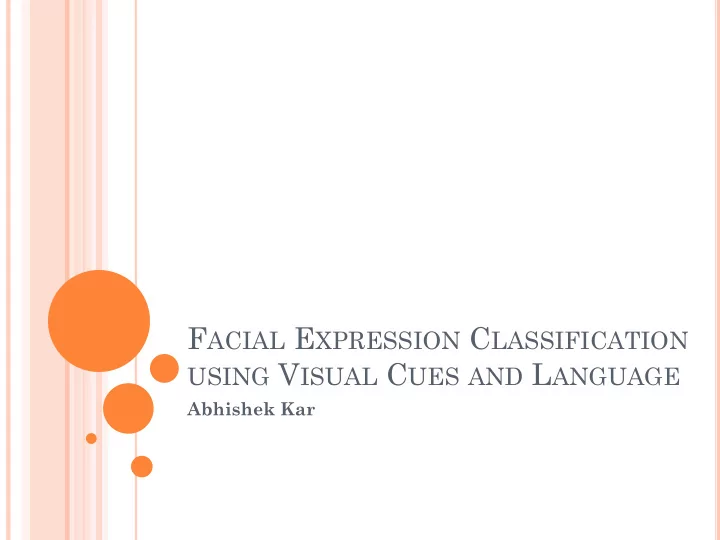

F ACIAL E XPRESSION C LASSIFICATION USING V ISUAL C UES AND L ANGUAGE Abhishek Kar
M OTIVATION Long standing problem Applications in HCI, indexing of videos, affective computing Availability of a large number of datasets Extended Cohn-Kanade (CK+) Dataset RU FACS Dataset JAFFE MMI Dataset Vast amount of literature available
T HE P ROBLEM Angry Disgust Surprise Image Happy Neutral Fear Sadness
M ETHODOLOGY Face detection (Viola Jones) Feature Extraction using Gabor Filters Dimensionality Reduction/Feature Selection Classification
F EATURE E XTRACTION Face detection done on the CK+ dataset and face patches resized to 48x48 Face patch converted into Gabor magnitude representation 72 Gabor filters used at 8 orientations and 9 frequencies Feature vector size for each image = 48x48x72 = 165888
F EATURE S ELECTION /D IMENSIONALITY R EDUCTION PCA Feature vector was reduced to various dimensions between 10 and 359 Best dimensionality was found to be around 60. Interesting to note that the Facial Action Coding System used to code various emotions has 64 action units. PCA able to find rough mapping to the Action Unit intensities??
F EATURE S ELECTION /D IMENSIONALITY R EDUCTION Adaboost Iterative algorithm combining a cascade of weak classifiers to classify a pattern We select the best features (weak learners) obtained by Adaboost for every one versus rest classification task. Final set of features – Union of all features obtained in the above step. Used these set of features for further classification
C LASSIFICATION SVM Used multiclass SVM (1 vs. 1) with linear kernel to classify data into 7 categories Used LibSVM library for Matlab Used multiclass SVM (1 vs. rest) approach with linear kernel Final decision based on margin of classification and not just voting MAP decision with parameter estimation using MLE – Baseline classifier
D ATASET Extended Cohn-Kanade CK+ Dataset 593 posed sequences from 123 subjects. Each sequence starts with a neutral expression and terminates with the peak expression. 327 of the 593 sequences are emotion labeled 7 expressions present in the database: Angry, Disgust, Fear, Happy, Sadness, Surprise, Neutral
R ESULTS Method Accuracy (Feature Selection + Classifier) (10 fold cross validation) PCA + SVM (1 vs. 1) 71.08% PCA + SVM (1 vs. rest) 72.19% PCA + Baseline 80.45% None + SVM (1 vs. 1) 75.39% None + SVM (1 vs. rest) 88.87% Adaboost + SVM (1 vs. 1) 80.43% Adaboost + Baseline 86.64% Adaboost + SVM (1 vs. rest) 94.72%
P ER E MOTION A CCURACIES Emotion No feature Adaboost selection Neutral 97.5% 98.05% Angry 91.65% 95.26% Disgust 98.04% 99.72% Fear 96.1% 98.04% Happy 98.6% 98.89% Sadness 94.16% 94.99% Surprise 97.78% 99.17%
C OMPARISION Accuracy on CK+ 95.00% 90.00% 85.00% 80.00% 75.00% Accuracy 70.00%
R ESPONSES ON V IDEOS Obtained English responses on 40 videos from 4 different emotion categories – Angry, Happy, Sad, Surprise Participants correctly identified the emotion almost all the time. 6 subjects – 10 responses each Responses transcribed into English Keywords observed – Distressed, Unhappy, Sad, Amazed, Extreme happiness, Frowned Problems Posed expression dataset. Expressions don’t seem natural.
T O DO Try to automatically identify the keywords in the responses and figure out the correct expression Obtain a rough classification on the basis of responses only If sufficient descriptive adjectives are obtained, I will try to assign different intensities to various images and try to find a correlation between high intensity images (or low intensity) in the same expression.
R EFERENCES Recognizing facial expression: Machine learning and application to spontaneous behavior – Bartlett et al. – CVPR 2005 The extended Cohn-Kanade dataset (CK+): A complete dataset for action unit and emotion- specified expression – Lucey et al. – CVPRW 2010
Recommend
More recommend